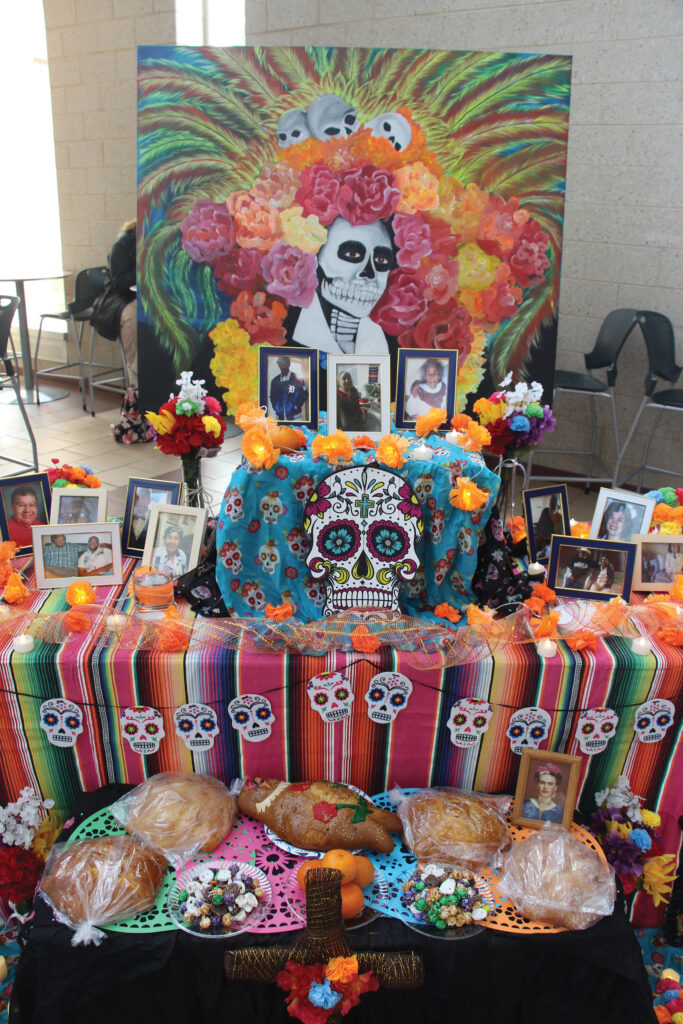Instead of mourning in black clothing and silent ceremonies, those who observe Día de los Muertos choose to celebrate the lives of their loved ones who passed.
During this celebration, an altar for those who passed away is set up, food is made and crafts are created. It is believed in Mexican culture that the Day of the Dead is a time when the spirits of those who have died can travel back to celebrate the holiday with loved ones.
On Thursday, Nov. 2, the Hispanic/Latino Cultural Center held a Día De Los Muertos celebration. According to the Director of HLCC Sonia Trevino, the Day of the Dead was an early Aztec tradition that was celebrated primarily in Mexico, but many other Latin American countries had their own celebrations.

As the director, Trevino helped plan the event for students to learn more about the holiday and its cultural significance.
“I want people to learn what the day of the dead means culturally in Hispanic/Latino culture,” Trevino said. “I want them to learn about the way we choose to honor the dead and to celebrate their life.”
Although the holiday originated in Mexico, people from many different cultures have started participating in the tradition to help honor a loved one who has passed.
“For most people when someone passes away, it’s a sad, traumatic event that comes with strong grief,” Trevino said. “I think the tradition of the Day of the Dead is an important way for us to celebrate life and realize that when we think of someone who has passed, it doesn’t always have to be sad.”
For HLCC special projects assistant Massiel Calderon, this event was her first time celebrating the Day of the Dead as she is from the Dominican Republic and this holiday is mostly a Mexican tradition. She often talks to her children about death to help them understand and celebrate it.
“It’s beautiful to celebrate the dead,” Calderon said. “To see Mexico embrace death as a part of their culture, it teaches a good way to cope with the loss of a loved one.”
As a part of the celebration, it’s tradition to set up an altar for the dead. According to Calderon, these altars hold the dead’s favorite food, pictures, water, salt and sugar skulls, known as Calaveras. Each thing on the altar has a deeper reason for its being there.
“The water is because they’re thirsty after their long journey and the salt is to keep them protected,” Calderon said. “We put the pictures up in remembrance of those who have passed. The reason for the skulls is to remind the spirits that they must go back after the journey here.”
During the event, attendees had the opportunity to see an altar, try some of Mexico’s important food staples and decorate skulls of their own.
Associate professor Lucero Flores-Paez decorated sugar skulls with students. She explained that the Day of the Dead and Halloween are not connected, even though they may seem like it.
“The best part is that there are different celebrations in different countries. In Guatemala, one of their traditions is the Barriletes,” Flores-Paez said. “This is the tradition of the flying kite because in Guatemala they believe that their ancestors need to be guided by a flying object.”
The Day of the Dead tradition is continuing to grow and become more popular. The celebration is one big party to help honor those in life who have passed.
“The Day of the Dead is to remember to celebrate the lives our loved ones lived,” Trevino said. “It’s important to not always think of the sadness and that they’re no longer with us. And that’s what I hope people took away from coming to this event,” Trevino said.
To further celebrate and teach, Ferris will be having their annual Day of the Dead ball on Friday, Nov. 10 starting at 5:30 p.m. The dance is open to everyone and will offer the attendees refreshments and snacks.
